13 of the Best Accidental Innovations - Mistakes that Worked

"Practice makes perfect." "Everyone makes mistakes." "To err is human." "Nobody bats 1.000."
"Practice makes perfect." "Everyone makes mistakes." "To err is human." "Nobody bats 1.000."
We're sure you've heard these and many more of the classic soothing cliches that are typically imparted by a well-meaning friend or loved one on occasions where you didn't get things quite right. They're certainly all true, and nobody in this world will ever go down the road of life without encountering their share of potholes, speed bumps, and flat tires along the way.
Still, mistakes are learning opportunities and nearly any mistake we make has value in that we can learn from them. Every once in a great while though, somebody makes a mistake that is not only a learning experience but is also their ticket to millions of dollars and immortal fame. These are the kinds of miscues we'll be sharing with you today. We're going to examine cases of people striking it rich by striking out.
Here are 13 of the best inventions that were conceived purely by accident. If any look familiar, it may be because you've already seen them in our generic product names blog post.
1. Potato Chips

It's pretty hard for anyone these days to imagine life without potato chips. They're one of the old standbys that are always just there no matter what. Be it a party, vending machine, grocery store, cafeteria, you can always count on crispy, delightful potato chips to be present. Considering that they've now been with us for 164 years, it's not so hard to see why they're so ingrained in our food lives. What you probably don't know is that they were originally intended to spite and not to satisfy.
The year was 1853 and the location was the Moon Lake Lodge Resort in Saratoga, New York. While most Americans looked at potatoes with scorn at the time, a dish called French Fried Potatoes (which were much thicker and larger than our modern French Fries) were one of the few potato dishes to be respected. Thomas Jefferson encountered them on a visit to France and couldn't get enough of them.
One night, a short-tempered chef named George Crum was preparing French Fried potatoes for an equally short-tempered customer in this New York restaurant. After Crum's first batch was brought to the table, the finicky customer said they were too thick and demanded they be sent back to the kitchen. Mr. Crum then made a thinner portion, but this serving was spurned as well.
Getting a bit hot under the collar, Crum decided to irk the customer by cutting the potatoes as thinly as he possibly could and dousing these thin slices with salt. He then watched the customer receive his order, anticipating a comically angry response. Instead, the diner couldn't have been happier. He loved this new food and invited the other patrons to share his portion. As you might expect, they were all impressed too.
Before long, these new "Saratoga Chips" were a sensation and George Crum opened his own restaurant where these were the flagship item. This was a successful venture, but for the next 60 years, potato chips, as they were now called, were mostly just a New York and New England treat. This all changed in the 1920s when native southerner Herman Lay (gee, where do you think this is going?) happened to try some chips out on a business trip up north. He knew a good business opportunity when he saw one, and before long, he was making his own chips which he sold out of the trunk of his car throughout the South.
Lay eventually made chips his full-time job and in the early 1960s, he merged his business with Frito to form Frito-Lay, the biggest snack giant in America.
2. Penicillin
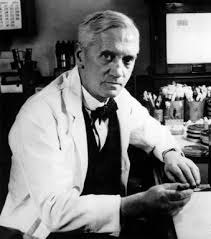
While it's not as fun or tasty as a potato chip, penicillin is an even more important invention. It's quite possibly the best thing ever to happen by mistake. The story of penicillin begins in 1928. At the time, there were virtually no antibiotics to speak of. A cut, scratch, or even an accidentally scraped knee could often prove to be deadly. Many a hospital was full of patients with infected wounds who had little choice other than to just be kept in a sterile environment and hope for the best. Sadly, the best is not what befell many of them.
It was during this era that a brilliant doctor by the name of Alexander Fleming was employed at London's St. Mary's Hospital. He was a leading bacteriologist and had very well earned his status as one of the most respected professionals in his field. After several consecutive months of hard work, Dr. Fleming decided to take a well-earned vacation. Uncharacteristically, though likely a result of all the labor he was putting in, he had left some petri dishes containing bacteria for a research project unattended during his leave.
Upon returning well-rested and ready to get back to work, the scientist learned he'd made an error. More importantly, he realized that in one petri dish, a island of mold had formed. This mold was surrounded by an area that was completely free of bacteria. Upon examination, he realized that this area was filled with a secretion of a mold called Penicillium notatum.
He began testing other virus and bacteria with this secretion and noted that it was effective in severely inhibiting, and in some cases, killing, the dangerous germs. He called this secretion "mold juice"1 and then set about the task of extracting the penicillin to be used on its own, as this was the agent that was stopping the bacteria.
This proved to be very difficult, but due to collaboration between Dr. Fleming and researchers at Oxford and Yale Universities, the goal was achieved. By the mid 1940s, penicillin was widely available and research into other antibiotics was underway. Many successful corporations and treatments resulted from this new medical field and countless lives were saved. This is one mistake that has been saving lives for over 70 years and will continue to do so for as long as humans continue to populate the Earth.
3. Super Mario Bros 2
 The discovery and development of penicillin is a pretty hard act to follow. This next item on our list may not have saved any lives, but it has certainly brought hours upon hours of entertainment to many and made millions for the Nintendo corporation.
The discovery and development of penicillin is a pretty hard act to follow. This next item on our list may not have saved any lives, but it has certainly brought hours upon hours of entertainment to many and made millions for the Nintendo corporation.
Almost every child of the 80s or 90s was at least casually familiar with the Nintendo Entertainment System and the Super Mario Bros franchise. This generation, as well as fans of retro gaming, would find it rather impossible to not notice the vast difference between "Mario 2", as it's usually called, and nearly any other side-scrolling Mario Bros game. The reason why this game was so different than any other? It wasn't originally intended to be a Mario-themed game at all!
The original NES Super Mario Bros game was released in 1985 and completely reinvented gaming as we know it. It was one of the first side-scrolling platformers and to say it was a hit with consumers would be a huge understatement. Due to its popularity, Nintendo wanted to develop and release a sequel that would be ready for the 1986 Christmas season. Unfortunately, this left developers with very little time, but they did manage to finish the game on time. However, this version of the game never made it to America.
The original SMB 2 was only released in Japan. When Howard Phillips, a product tester for Nintendo of America played the game, he was a bit worried. At first, he was struck by how the game looked almost identical to its predecessor. This shock was quickly replaced by the game's level of difficulty, which was unlike anything he'd ever encountered before. By the time he was done playing it, he'd arrived at the conclusion that the game was punishingly hard and would not be a pleasant experience for American gamers. Nintendo of America decided they couldn't release this version of the game, but still wanted a Mario Bros sequel. They soon found one by way of adapting an obscure Japanese video game called Doki Doki Panic to fit into the Mario universe. The only trouble is that it required some time to tweak, and wasn't released in the states until 1988. The wait would prove to be well worth it both for Nintendo and its legion of fans.
For some extra detail on how hard the original SMB 2 really was and how it came to be replaced, you can view the video below.
This game couldn't possibly have looked any more different from the original Super Mario Bros, and for good reason. It was originally a game that was designed with an Arabic fantasy setting, as can be observed through the many desert levels, magic flying carpets, general decor, and outfits worn by some of the characters. The four playable characters were replaced by Mario, Luigi, Toad, and Princess Toadstool (later renamed Princess Peach). Despite having four playable characters, Super Mario Bros 2 was a one player game. Despite this and all of the other very unexpected differences, this game was a smashing success with American gamers. Within a year of its release, it was the third best-selling game in the history of the NES and is still considered to be among the best video games of all time to this day.
4. Plastic
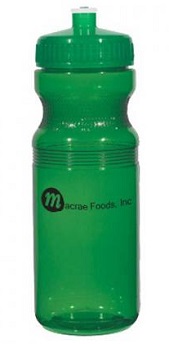 Plastic has at least some role to play in nearly every consumer product you can name that isn't a food or a drink. On second thought, even those items aren't exempt, as many of them either include plastic in their packaging or are consumed by way of plastic vessels. Our promotional BPA-free 28 oz Plastic Sports Bottle, pictured to the left, is ample proof of that.
Plastic has at least some role to play in nearly every consumer product you can name that isn't a food or a drink. On second thought, even those items aren't exempt, as many of them either include plastic in their packaging or are consumed by way of plastic vessels. Our promotional BPA-free 28 oz Plastic Sports Bottle, pictured to the left, is ample proof of that.
So just how did plastic come to be? Well, like everything else we're going to talk about today, it didn't happen intentionally. The credit for this marvelous mistake goes to Dr. Leo Baekeland, a Belgian scientist who committed his fabulous flub in 1907. At the time, he was attempting to find a cheaper and easier to procure alternative to shellac. Shellac was, and still is, derived from the secretion of female Lac Bugs, a species native to Southeastern Asia. At the time, it was mostly used for gloss coatings and finishes, as well as an insulator for the new industry of electronics.
Baekeland kept trying different chemical combinations to achieve his goal, but none seemed to work out. Eventually, he produced a mixture of phenol and formaldehyde blended together with various dry powder solutions. He subsequently named this concoction Novolak. Novolak couldn't do much to replace shellac, but the disappointment was short-lived. Dr. Baekeland quickly realized that his new invention could do many things that shellac could not. Upon seeing how malleable, heat resistant, and overall versatile it was, he proclaimed it to be, "The Material of 1,000 Uses"3. As it turned out, this was quite possibly the literal understatement of the century.
After some minor adjustments, Novolak became Baekelite, which was the first ever commercially available form of plastic. Bakelite is the common ancestor of all of the plastics that we use today. The world is eternally grateful for Dr. Baekeland's perseverance in the wake of what could be considered a failure, as he turned his unsuccessful experiment into one of the most important inventions of all time.
5. Play-Doh
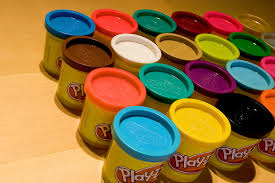
Play-Doh has been one of the most enjoyed and widely used children's toys/art supplies for as long as most people living today can remember. However, this creative clay that helps children to express themselves started out as a agent designed to eliminate rather than to create.
In the 1930s, Noah McVicker, the owner of a Cincinnati-based soap company, was commissioned to develop a putty that would be capable of removing coal stains from wallpaper. At the time, most homes still employed wood burning stoves for heat as well as a more primitive form of wallpaper that was relatively difficult to maintain.
Due to this, the prospect of a product that could easily remove black smudges from household walls was met with great enthusiasm. McVicker made good on this by creating a putty made from a simple, non-toxic solution of water, flour, mineral oil, boric acid, and salt.
For a while, this putty was a big hit and all was well. However, by the end of the second World War, more and more homes were employing oil furnaces and newer, easier-to-clean wallpaper was being produced. The result was the obsolescence of McVicker's putty and the near demise of his business. By this time, Joseph McVicker, Noah's nephew, was working for the company.
As luck would have it, Joseph happened to have a sister-in-law by the name of Kay Zufall who was a nursery school teacher. To be more specific, she was a nursery school teacher who had recently read an article about the viability of non-toxic putties as motor-skill building art supplies for young children. Shortly after, she had requested some of McVicker's putty for use in her classroom, and it proved to be a big hit.
Seeing how much fun the little tykes were having with this non-toxic putty pulled the McVickers out of their sadness as they realized their flagship product could be reborn as a best-selling children's toy. All that was needed was a name. Noah and Joseph proposed "Modeling Compound", while Kay conceived the much more catchy "Play-Doh".
The trio soon began publicly demonstrating Play-Doh and it caught on like wildfire. By the 1960s, it was heavily advertised and selling at a rate beyond their wildest dreams. In 1965, they sold the rights to Play-Doh to General Mills for $3 million. To put it into proper context, this was a sale that would be equivalent to $23,506,571.43 today. Not bad for a product that was at one time killed by fancy new wallpaper.
6. Stainless Steel
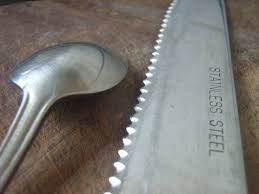 Since the early 1800s, the quest for corrosion-resistant metals was on the minds of many a scientist. Guns, tools, silverware, and other metallic items often fell victim to rust before their time. By the end of the 1800s, studies had proven that adding higher levels of chromium to steel products helped to protect against corrosion, but the ideal balance had yet to be struck.
Since the early 1800s, the quest for corrosion-resistant metals was on the minds of many a scientist. Guns, tools, silverware, and other metallic items often fell victim to rust before their time. By the end of the 1800s, studies had proven that adding higher levels of chromium to steel products helped to protect against corrosion, but the ideal balance had yet to be struck.
Now we'll fast forward a few years later to 1912. Harry Brearley, an English laboratory research director, was continuing the war on corrosion. He was approached by a gun manufacturer who wanted to produce barrels that wouldn't rust out quite so quickly. Brearley enthusiastically accepted this project and work was soon underway. He experimented with several different alloys and eventually produced one sample that had a chromium component of 12.8%, along with a 0.24% carbon content.

As was the case with nearly all metals that were created for this purpose, this alloy had to be tested with a special kind of acid to see just how corrosion resistant it could be. When this particular alloy was exposed to the acid, it didn't react at all. Brearley kept on trying stronger and stronger acids, but nothing seemed to work, so he couldn't quite determine the corrosion resistant properties.
What he was able to determine was that he'd stumbled across the most erosion resistant alloy he'd ever seen. While this didn't meet his goal of creating gun barrels that wouldn't rust, it did create a huge opportunity - namely, Brearley realized he'd come up with an alloy that would change the cutlery industry forever.
After much initial success, Brearley collaborated with a friend to come up with a coating that would also create resistance to corrosion while maintaining the newly-found erosion resistant effects of his alloy. The duo succeeded in this effort and stainless steel was born.
All told, in addition to the chromium and carbon, the final alloy consisted of silicon, manganese, nickel, and molybdenum. The recipe remains largely unchanged today, and is seen in a variety of industrial and consumer products, including our promotional stainless steel water bottles.
Pictured to the right is our 24 oz Custom Logo Engraved Stainless Steel Water Bottle, which owes its existence to Mr. Brearley's initially unsuccessful attempt at creating a corrosion resistant alloy. We also have his efforts to thank for artificial bone replacements (especially hips), automobile construction, modern building construction, modern cookware, offshore oil rigs, the strongest and most durable metal pipes, and several other innovations that are crucial to our society.
7. Viagra

Yes, this little blue pill may be fodder for several off-color jokes, but it also has dramatically improved the quality of life for many people around the world. While most everyone knows what Viagra is used for now, its rejuvenating benefits were not its originally intended purpose. While this can't entirely be chalked up to being a mistake, what Viagra eventually became famous for was completely unintentional.
Viagra was created by Pfizer with the original purpose of serving as a medication to help people with high blood pressure. It was prescribed to many middle aged and elderly men, who tend to be one of the demographics most heavily represented when it comes to hypertension. Many of these men were suffering from impotence.
In some cases, it was just a factor of the aging process and in other cases, prostate cancer surgery was the culprit. An overwhelming majority of the men who were dealing with this condition and were prescribed Viagra for their blood pressure were overjoyed to find that this medication killed two birds with one stone.
Through a combination of blunt candor, heartfelt empathy, and humor, Viagra and its famous spokesmen have given many men (and women) their old lives back. One example is the Pepsi commercial located below, in which Bob Dole manages to have some fun at his own expense, all while helping to normalize potency treatment.
8. Cardiac Pacemakers
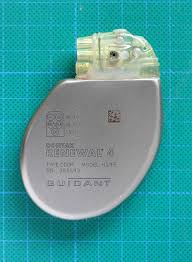 When your last name is Greatbatch, you likely feel a need to back your surname up from a pretty early age. Dr. Wilson Greatbatch did just that by inventing the cardiac pacemaker. What many people do not know, including those who depend on these items for survival, is that the pacemaker was invented entirely by mistake.
When your last name is Greatbatch, you likely feel a need to back your surname up from a pretty early age. Dr. Wilson Greatbatch did just that by inventing the cardiac pacemaker. What many people do not know, including those who depend on these items for survival, is that the pacemaker was invented entirely by mistake.
Dr. Greatbatch was a physician and multiple inventor who was grappling with the task of creating a electronic device that would serve the purpose of recording heartbeat patterns. While developing one of his prototypes, the doctor accidentally added an extra, incorrect electronic component. He realized his mistake when testing his contraption, but he also realized something far more important; the mistake he made led to this device being able to produce pulses of electricity2.
Immediately, Dr. Greatbatch knew that this creation had the potential to act as a metronome of sorts for the human heart. This proved to be correct, as his pacemaker had the ability to send electric shocks through the human body that caused the correct muscles to flex on schedule, allowing for a timely and healthy heartbeat. After some perfecting modifications, the cardiac pacemaker was patented in 1962 and has saved thousands of lives since.
Dr. Greatbatch would go on to produce and patent several more inventions, both within the medical field and in other areas. Sadly, we lost this brilliant man in 2011, but he continues to live on through the lives he's saved and the additional saved lives yet to come.
9. Teflon
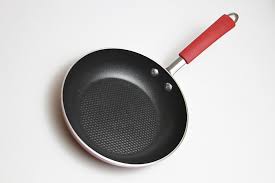
While Teflon is now synonymous with the non-stick frying pans that take the frustration out of flapjacks, its existence is the result of a lucky blunder on the part of a DuPont employee. This now-famous DuPont employee was named Ray Plunkett and he made his fortuitous fumble in 1938.
Mr. Plunkett started life as a person of modest means. His early years were spent as a child farmer in rural Ohio during the dawn of the Great Depression. From the beginning, he was a boy who had a passion for science, which led the way to him becoming a man who graduated from Ohio State University with a PhD in chemistry. He was hired by DuPont shortly after his graduation and would remain with the company until his retirement.
In 1938, Plunkett was attempting to produce a chemical compound that would work as a refrigerating agent. One of the compounds he came up with was TFE (Tetrafluoroethylene Gas). He froze this gas in cylindrical containers, planning to later extract the gas and mix it with chlorine. When he attempted to extract the gas, he found himself unable to do so. Curiously, when he weighed the storage cylinder, its weight had not changed from what it was when it was empty, despite the fact that it now contained a solid white powder.
Plunkett carefully extracted and tested this powder. He soon found that it had great heat-resistance qualities and could also reduce surface friction. He fine-tuned this substance a bit before DuPont was ready to release it commercially as Teflon. After additional work, he was able to produce a less expensive version that found its way into all kinds of kitchenware by the mid 1950s. Every time you scoop some sunny-side-up eggs from your frying pan and don't have to scrape away the remains afterward, you have Ray Plunkett and his unintentional invention to thank.
10. Microwave Ovens

Few items offer the level of speedy convenience that a microwave oven can bring to the table. It can reduce an hours-long cooking process to mere minutes and is so easy to operate that even a young child (properly supervised) can prepare a family dinner. While their application is culinary in nature, they were conceived when their inventor was trying to create military radar technology.
During World War II, Dr. Percy Spencer was experimenting with magnetrons. Magnetrons are extremely high-powered vacuum tubes that produce very small electromagnetic wavelengths, which are often referred to as microwaves. His goal was to use these invisible rays to improve military radar technology to assist the allied forces in combat.
One day, while at work in the laboratory, Dr. Spencer was a bit displeased to find a candy bar in his pocket began melting. It wasn't a warm day and it wasn't particularly warm within the laboratory, so he was a bit confused as to how the candy bar in his pocket began melting. His confusion didn't last long, as he quickly deduced that it was working with the magnetrons that had caused his candy bar to melt. He enthusiastically tried using microwaves to heat other foods and met with similar success.
After continued research and a lot of hard work, Dr. Spencer produced the first commercially available microwave oven, called the 1161 Radarange, in 1954. It was quite large, expensive, and consumed a lot of energy, but it was still successful. In 1967, a much improved microwave oven was finally developed and available for purchase. Within a few short years, the version that we know and love today was up and running.
If you've ever wondered how a microwave oven works, this video will answer your questions.
11. Slinky
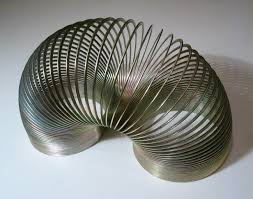
Though it is now known as one of the most popular toys of all time, the Slinky was not originally designed to be fun. The United States Navy was experiencing trouble keeping important equipment steady on its ships, particularly during storms at sea. A method to eliminate this problem and the damage it was causing was necessary, and a mechanical naval engineer named Richard Jones was one of the many people to take on the task.
Jones planned to use specialized springs to stabilize the naval equipment. One of the models he constructed consisted of 80 feet of metal coiled up into a 2 inch tall spring. These didn't end up being very effective in promoting stability, but thanks to a moment of fleeting clumsiness, Jones soon realized his efforts hadn't been wasted.
After bumping into the shelf on which he was storing his springs and knocking several of them over, Jones was struck by what he observed. Rather than just falling into a tangled, clattering mess, his springs appeared to "walk" across the room. He immediately saw the potential for this to become a popular toy for children and with the assistance of his wife, came up with the name "Slinky". This name was inspired by the husband and wife team searching a dictionary for the perfect word. Upon seeing slinky defined as "graceful in movement, line, or figure", they knew they had a winner.
At first, the toys were slow to catch on. This changed quickly after Mr. and Mrs. Jones conducted a public demonstration of the Slinky in a Philadelphia department store. Over 400 units were sold on that day alone and by Christmas of 1945, it had become one of the hottest items for parents to put under the tree. 72 years later, they're still a childhood standby.
Here's a free Slinky-related tip: If your Slinky doesn't walk quite the way you want it to, try constructing your own, miniature staircase out of cardboard, boxes, or anything else you can stack. These shorter and narrow steps will result in optimum Slinky performance.
12. Minoxidil
 You might better know Minoxidil by the brand name of Rogaine (for men) or Regaine (for women). Produced by Johnson & Johnson, it's a cream that helps the folically challenged among us to thicken thinning hair and in some cases, bring hair back to areas of the scalp that have gone completely bald.
You might better know Minoxidil by the brand name of Rogaine (for men) or Regaine (for women). Produced by Johnson & Johnson, it's a cream that helps the folically challenged among us to thicken thinning hair and in some cases, bring hair back to areas of the scalp that have gone completely bald.
Much like Viagra, Minoxidil started out as a drug that was intended to treat high blood pressure, particularly in older patients. In the early days, it was sold in pill form. Several people who took this medication soon discovered that their hair was growing back after long since accepting a sentence of baldness. They were pretty happy about that. What they weren't so happy about was the fact that it also caused them to experience a sudden and rapid growth of body hair.
Not wanting to pass up on a good thing, this pill was soon converted into a lotion that could be applied directly to the scalp. This allowed it to regrow hair on the head, while sparing other areas of the body from hirsuteness. By 1985, Minoxidil was available by prescription to treat hair loss and in 1997, it was released by Johnson & Johnson as an over-the-counter hair loss remedy. While it doesn't work for everybody, it's been able to help many people regrow their hair as well as their self-esteem and confidence.
13. Many of Our Most Beloved Snacks

An all-time favorite of cookie lovers everywhere, chocolate chip cookies were invented in 1938 by professional chefs Ruth Wakefield and Susan Brides. Ms. Wakefield was the owner of the Toll House Inn, a small bed and breakfast type style hotel located in Whitman, Massachusetts. There are disputed accounts of how the first chocolate chip cookies came to be, but some sources have it that they weren't a planned product.
According to this version of the story, Brides and Wakefield decided to create cookies that would have an even level of chocolate distribution throughout its surface. To achieve this, they cut up a bar of Nestle semi-sweet chocolate and added it to the cookie dough. When pulled from the oven, the cookies were still mostly tan in color and the chocolate pieces had failed to congeal. Nevertheless, the cookies were a big hit with both chefs and their customers.
Other sources say that chocolate fragments were the plan from the outset, but the former makes for a better story. Whatever the case, these chocolate cookies will celebrate their 80th anniversary next year, which is as good of an excuse as any to indulge in as many as you can.
Inventions that were mistakes for the better
We hope you had fun learning about some of our greatest innovations that were accidentally invented. Don't be too hard on yourself when you make a little gaffe. After all, next time something is accidentally dropped, accidentally knocked over, or just doesn't turn out right, it could make you a fortune!
Would you like to learn about more items that were accidentally invented? Perhaps you'd like to hear the tale of how Spencer Silver invented Post It notes, the story of baker's chocolate, bubble wrap, artificial sweetener, corn flakes, or how Silly Putty came to be. Let us know and we'll get to work on a sequel to this article!
Works Cited
1. "American Chemical Society International Historic Chemical Landmarks - Discovery and Invention of Penicillin"
Retrieved from http://www.acs.org/content/acs/en/education/whatischemistry/landmarks/flemingpenicillin.html on Oct 31, 2017
2. "The Hearbeat of Invention: How Pacemaker Creator Wilson Goodbatch Saved Countless Lives"
IntellectualVentures.com (Nov 8, 2016)
https://www.intellectualadventures.com/insights/archives/the-heartbeat-of-invention-how-pacemaker-creator-wilson-goodbatch- saved-co/
3. Cyran, Pamela and Gaylord, Chris
"The 20 Most Fascinating Accidental Inventions"
The Christian Science Monitor (Oct 5, 2012)
https://www.csmonitor.com/Technology/2012/1005/The-20-most-fascinating-accidental-inventions/Plastic






